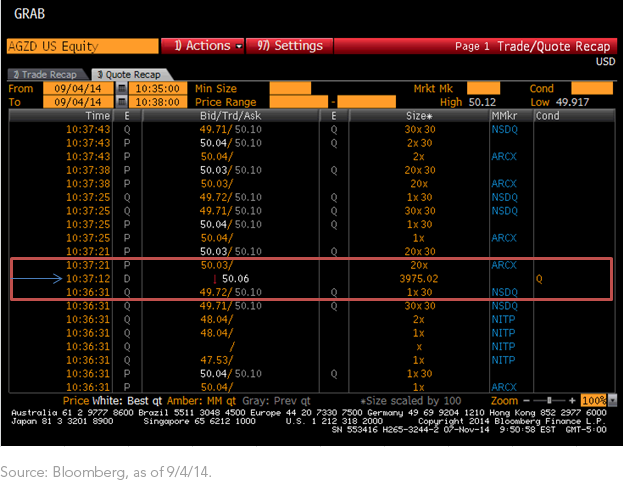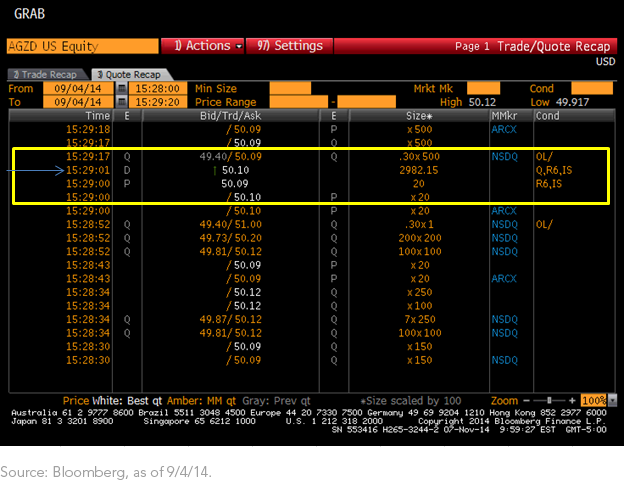Sourcing Liquidity in Rising Rate Strategies


 The highlighted box shows that 397,502 shares (about $20 million worth) traded at $50.06. The offer on screen at the time was $50.10. So 65x the average daily volume of the ETF traded 4 cents inside the offer. We would interpret this as having no impact on the ETF price.
Just to be sure, let’s look at the second print. That same day at 15:29:01, 298,215 shares (about $15 million worth) of AGZD printed at $50.10.
The highlighted box shows that 397,502 shares (about $20 million worth) traded at $50.06. The offer on screen at the time was $50.10. So 65x the average daily volume of the ETF traded 4 cents inside the offer. We would interpret this as having no impact on the ETF price.
Just to be sure, let’s look at the second print. That same day at 15:29:01, 298,215 shares (about $15 million worth) of AGZD printed at $50.10.
 Again, the highlighted yellow box shows the print by the arrow at $50.10, and the offer at the time was $50.10. Again, no price impact to the ETF.
This is an illustration of the theory of liquidity that we explained. This customer wanted to hedge the interest rate risk in the portfolio with an ETF that didn’t have much regular daily volume. The customer did due diligence on the Fund and its underlying liquidity by using all the available resources, including the capital markets team at WisdomTree. What the customer discovered is that AGZD fit the investment needs and that $240 billion of liquidity was available in the marketplace. The customer then worked with the trading platform to use the services of a market maker to translate that $240 billion of underlying liquidity into the ETF at the requested size and time. The result was two trades done without price impact.
Additionally, it is worth noting that liquidity is available on both entry and exit to the strategy. Market makers are often agnostic regarding buys or sells and just look to hedge themselves with underlying liquidity. Thus, when the customer intends to sell a position, regardless of AGZD’s daily onscreen volume, the volume of the underlying basket will again be available, just as it was on the above examples.
1Source: Chicago Mercantile Exchange (CME), as of 8/31/14.
2Source: Bloomberg, based on 30-day average volume, 9/4/14.
3Source: Barclays, as of 10/31/14.
4Sources: Federal Reserve, Bloomberg, as of 10/29/14.
5Source: Barclays, as of 10/31/14.
6Source: Chicago Mercantile Exchange (CME), as of 8/31/14.
Again, the highlighted yellow box shows the print by the arrow at $50.10, and the offer at the time was $50.10. Again, no price impact to the ETF.
This is an illustration of the theory of liquidity that we explained. This customer wanted to hedge the interest rate risk in the portfolio with an ETF that didn’t have much regular daily volume. The customer did due diligence on the Fund and its underlying liquidity by using all the available resources, including the capital markets team at WisdomTree. What the customer discovered is that AGZD fit the investment needs and that $240 billion of liquidity was available in the marketplace. The customer then worked with the trading platform to use the services of a market maker to translate that $240 billion of underlying liquidity into the ETF at the requested size and time. The result was two trades done without price impact.
Additionally, it is worth noting that liquidity is available on both entry and exit to the strategy. Market makers are often agnostic regarding buys or sells and just look to hedge themselves with underlying liquidity. Thus, when the customer intends to sell a position, regardless of AGZD’s daily onscreen volume, the volume of the underlying basket will again be available, just as it was on the above examples.
1Source: Chicago Mercantile Exchange (CME), as of 8/31/14.
2Source: Bloomberg, based on 30-day average volume, 9/4/14.
3Source: Barclays, as of 10/31/14.
4Sources: Federal Reserve, Bloomberg, as of 10/29/14.
5Source: Barclays, as of 10/31/14.
6Source: Chicago Mercantile Exchange (CME), as of 8/31/14.Important Risks Related to this Article
There are risks associated with investing, including possible loss of principal. Fixed income investments are subject to interest rate risk; their value will normally decline as interest rates rise. The Fund seeks to mitigate interest rate risk by taking short positions in U.S. Treasuries, but there is no guarantee this will be achieved. Derivative investments can be volatile, and these investments may be less liquid than other securities, and more sensitive to the effects of varied economic conditions. Fixed income investments are also subject to credit risk, the risk that the issuer of a bond will fail to pay interest and principal in a timely manner or that negative perceptions of the issuer’s ability to make such payments will cause the price of that bond to decline. The Fund may engage in “short sale” transactions of U.S. Treasuries, where losses may be exaggerated, potentially losing more money than the actual cost of the investment, and the third party to the short sale may fail to honor its contract terms, causing a loss to the Fund. While the Fund attempts to limit credit and counterparty exposure, the value of an investment in the Fund may change quickly and without warning in response to issuer or counterparty defaults and changes in the credit ratings of the Fund’s portfolio investments. Investing in mortgage- and asset-backed securities involves interest rate, credit, valuation, extension and liquidity risks and the risk that payments on the underlying assets are delayed, prepaid, subordinated or defaulted on. Due to the investment strategy of certain Funds, they may make higher capital gain distributions than other ETFs. Please read the Fund’s prospectus for specific details regarding the Fund’s risk profile.

Rick Harper serves as the Chief Investment Officer, Fixed Income and Model Portfolios at WisdomTree Asset Management, where he oversees the firm’s suite of fixed income and currency exchange-traded funds. He is also a voting member of the WisdomTree Model Portfolio Investment Committee and takes a leading role in the management and oversight of the fixed income model allocations. He plays an active role in risk management and oversight within the firm.
Rick has over 29 years investment experience in strategy and portfolio management positions at prominent investment firms. Prior to joining WisdomTree in 2007, Rick held senior level strategist roles with RBC Dain Rauscher, Bank One Capital Markets, ETF Advisors, and Nuveen Investments. At ETF Advisors, he was the portfolio manager and developer of some of the first fixed income exchange-traded funds. His research has been featured in leading periodicals including the Journal of Portfolio Management and the Journal of Indexes. He graduated from Emory University and earned his MBA at Indiana University.

